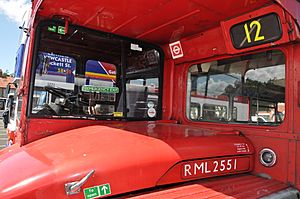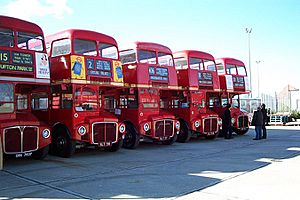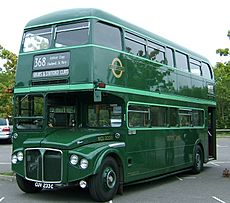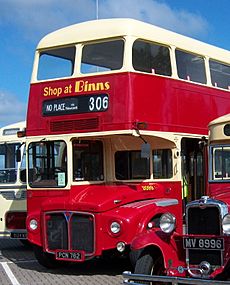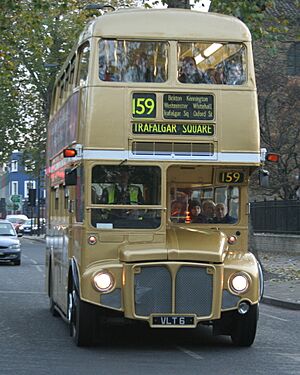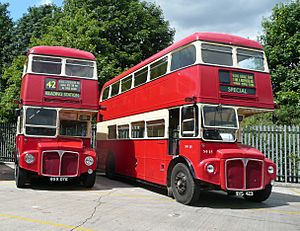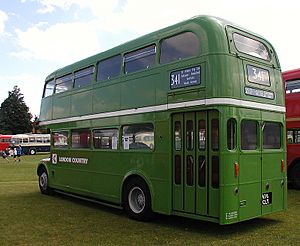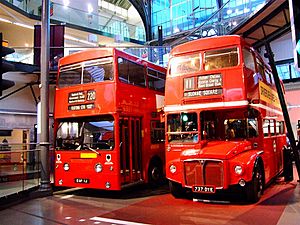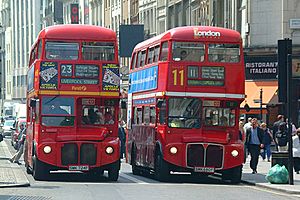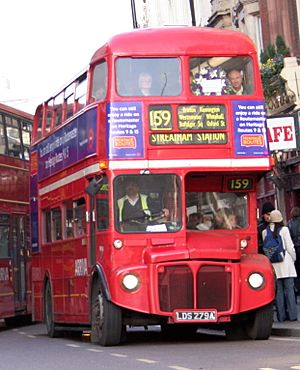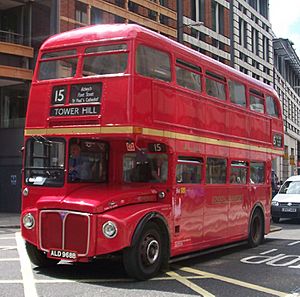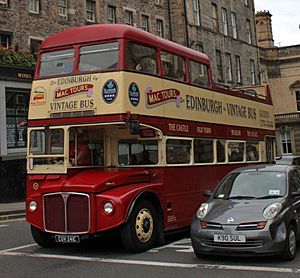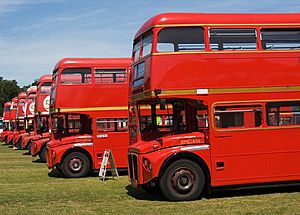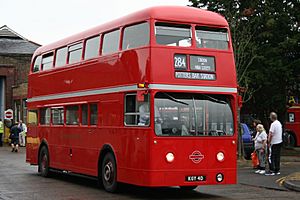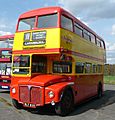AEC Routemaster facts for kids
Quick facts for kids AEC Routemaster |
|
|---|---|
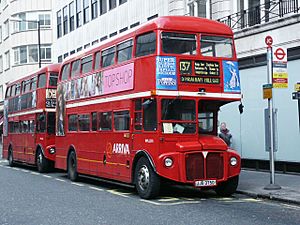
Arriva London Routemasters at Oxford Circus in March 2004
|
|
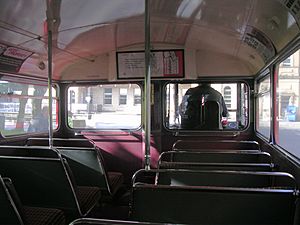
RM1414 lower deck in October 2006
|
|
| Overview | |
| Manufacturer | Associated Equipment Company |
| Production | 1954–1968 |
| Body and chassis | |
| Layout | Front-engine, rear-wheel-drive |
| Doors | 0 passenger doors, 1 permanently-open entrance at the back and 1 driver's door |
| Floor type | Step-entrance |
| Chassis | Integral, with front and rear subframes |
| Powertrain | |
| Engine | AEC AV590 9.6 L or AEC AV690 11.3 L or Leyland O.600 9.8 L 6-cylinder diesel Retrofits: Cummins ISCe/Cummins ISBe DAF Iveco Scania |
| Capacity | 57–72 seated |
| Power output | 115 hp (86 kW) (AEC AV590) |
| Transmission | AEC 4-speed automatic/semi-automatic |
| Dimensions | |
| Length | 27 ft 6 in (8.38 m) 30 ft 0 in (9.14 m) |
| Width | 8 ft (2.44 m) |
| Height | 14 ft 4+1⁄2 in (4.38 m) |
| Weight | 7.35 long tons (7.47 t; 8.23 short tons) |
| Chronology | |
| Predecessor | AEC Regent III RT |
| Successor | New Routemaster (spiritual) |
The AEC Routemaster is a famous double-decker bus from London. It was designed by London Transport and built by the Associated Equipment Company (AEC) and Park Royal Vehicles. The first test bus was ready in 1954, and the last one was made in 1968.
These buses had their engine at the front and an open platform at the back. This open platform allowed people to hop on and off quickly. The first Routemasters started carrying passengers in London in February 1956. They were used for a long time, with the last ones leaving regular service in December 2005. However, a few special Routemasters kept running on "heritage routes" in central London until April 2021.
Most Routemasters were made for London. But some were also built for British European Airways (an airline) and the Northern General Transport Company. In total, 2,876 Routemasters were built. About 1,280 of them still exist today.
The Routemaster was a very clever design. It lasted longer than many newer buses that were supposed to replace it. It was even used by other bus companies around the UK after London's bus services became private. In 2006, the Routemaster was voted one of Britain's top 10 design icons. Other famous designs on the list included Concorde (a supersonic jet) and the Mini car. Later, a new bus called the New Routemaster was designed, inspired by the classic Routemaster. It started service in 2012.
Contents
What Made the Routemaster Special?
The Routemaster was designed between 1947 and 1956. The goal was to create a bus that was lighter, used less fuel, was easier to drive, and cheaper to fix. The team that designed it was led by AAM Durrant and Colin Curtis, with Douglas Scott styling the look of the bus.
The new Routemaster could carry 64 passengers. This was more than the older RT buses, even though the Routemaster was lighter. When they first came out, Routemasters replaced trolleybuses and older diesel buses in London.
The Routemaster was built using lightweight aluminium, similar to how aircraft were made during World War II. This made the bus much lighter. It also had new features for a bus, like independent suspension at the front, power steering, an automatic gearbox, and power-hydraulic braking. Drivers were surprised by how light and easy to handle the bus was compared to older models.
The Routemaster was one of the first "integral" buses. This means its body and chassis (the frame) were built together as one unit, rather than having a separate body placed on top of a chassis. This design helped save weight.
How Were Routemasters Tested?
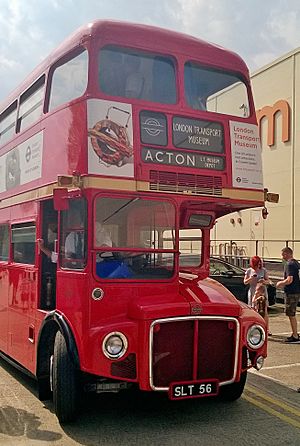
London Transport tested four prototype (early test) Routemasters between 1956 and 1958. The first two were built at London Transport's own workshops. The third was built by Weymann, and the fourth, a special coach version, was built by Eastern Coach Works. The third and fourth test buses used Leyland engines. The Routemaster was first shown to the public in 1954.
In 1961, 24 longer Routemasters (called RMLs) were built for testing. These were about 30 feet long, compared to the standard 27.5 feet. They went into full production in 1965. In 1962, a front-entrance version (RMF) was tested. This led to a small number of RMF and RMA buses being made.
In 1964, AEC also started working on a prototype bus called FRM1. This bus had its engine at the back and an entrance at the front. It was finished in 1966 and was used in London until 1983. People nicknamed it the "Fruitmaster."
How Many Routemasters Were Made?
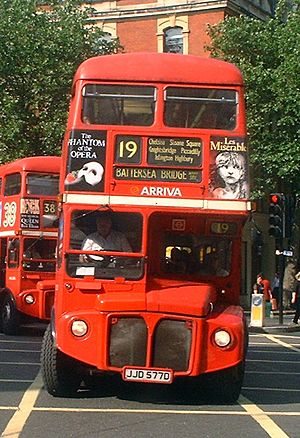
The main parts of the Routemaster were made at AEC's factory in Southall. The bodies were built and the buses were put together at Park Royal Vehicles. Many Routemasters also used Leyland engines.
Even though rules allowed longer buses, most Routemasters were the standard 27.5 feet long. Longer versions were delayed because bus workers were worried about the extra work for conductors on bigger buses.
Here's a table showing the different types of Routemasters:
| Class | Type | Length | Number | Notes |
|---|---|---|---|---|
| RM | standard bus | 27.5 feet (8.38 m) | 2,123 | |
| RML | long bus | 29.91 feet (9.12 m) | 524 | |
| RMC | coach | 27.5 feet (8.38 m) | 69 | |
| RCL | long coach | 29.91 feet (9.12 m) | 43 | |
| RMF | front-entrance bus | 29.91 feet (9.12 m) | 51 | most for Northern General Transport Company |
| RMA | front-entrance bus | 27.5 feet (8.38 m) | 65 | for British European Airways |
| FRM | front-entrance bus | 31.3 feet (9.54 m) | 1 | engine at the rear |
RM and RML Buses
London Transport received 2,123 standard RMs and 524 longer RMLs. The RML was basically a standard RM with an extra window section in the middle. This added eight more seats. This was easy to do because the Routemaster was designed in a modular way, meaning parts could be added or changed easily.
Both RM and RML buses had a space near the back stairs where the conductor could stand when not collecting fares. RMs could seat 64 passengers, while RMLs could seat 72.
RMC and RCL Coaches
The RMC was a coach version of the Routemaster, used for longer Green Line routes. RMCs had softer suspension and more comfortable interiors for longer journeys. They also had an electric door instead of an open platform. The RCL was a longer version of the RMC with a bigger engine. RMCs seated 57 passengers, and RCLs seated 65.
RMF and RMA Buses
The RMF and RMA buses were Routemasters with front entrances. They were mainly used outside London and by airlines. Like the RMC/RCL, they had an electric door, but it was at the front, next to the stairs.
Northern General Company
The Northern General Transport Company bought RMF buses in 1964/65. They bought 50 of them, plus the prototype RMF1254. These buses had Leyland engines and were designed for longer routes. They also had a single front destination sign and sliding windows.
Northern Routemasters were popular with their drivers because they were fast on long routes and had power steering for busy city services. They were used in places like Newcastle upon Tyne and Sunderland. However, by the 1970s, it became too expensive to have conductors on these longer routes. So, Northern General started replacing them in 1977, and the last ones were removed from service in 1980.
British European Airways
British European Airways (BEA) bought 65 shorter RMA buses in 1966/67. They used them for their airport bus service between the West London Air Terminal and Heathrow Airport. These buses were designed to go up to 70 mph on the M4 motorway. BEA stopped using them in 1979, and all 65 RMAs were sold to London Transport.
Was the Open Platform Safe?
The open platform at the back of the Routemaster could be risky. Passengers could get on or off even when the bus was moving. The conductor was there to help, but they also had to collect fares. So, they couldn't always stop all incidents. A former London mayor once said that about twelve people a year were hurt falling from Routemasters during his time in office.
What Colours Were Routemasters?
Because Routemasters lasted so long, some were painted in special colours to celebrate important events. For example, in 1977, 25 Routemasters were painted silver for the Queen's Silver Jubilee. In 2002, 50 buses were painted gold for her Golden Jubilee.
When London bus services became private in 1986, some companies used Routemasters in colours other than red. For example, Kentish Bus used them on route 19.
After bus services were deregulated (meaning more companies could run buses) in the UK in 1986, many operators outside London bought second-hand Routemasters. They were a cheap way to expand their fleets and looked unique. These buses were painted in many different colours and used in cities like Glasgow, Manchester, and Southampton.
One of the first companies to use Routemasters outside London was Stagecoach Group. They used them for their "Magic Bus" service in Glasgow in the late 1980s. In the mid-1980s, Clydeside Scottish bought 114 Routemasters for use in Glasgow.
In 1994, a new company called Reading Mainline built up a fleet of 45 Routemasters in Reading. They used conductors to make their service faster in the town centre. By 1998, Reading Mainline was sold, and their Routemasters were used until July 2000.
As it became more expensive to run older buses with two crew members (a driver and a conductor), the use of Routemasters outside London decreased in the 1990s. Many of these buses were then sent back to London to be used for parts or to increase the fleet size.
Green Routemasters
The first green Routemasters were 69 RMCs used for Green Line routes. These were the same length as the standard RMs but had more comfortable seats, luggage racks, and platform doors. Later, 43 longer RCLs were also made in green.
One hundred green Routemasters (RMLs) were delivered in 1965/66 for bus services in the countryside around London. On January 1, 1970, these green Routemasters were moved to a new company called London Country Bus Services. This company wanted to switch all its services to "one-man operation" (meaning only a driver, no conductor). By 1981, all the green Routemasters were no longer needed. Many were sold back to London Transport.
Why Did Routemasters Stop Being Used?
Their Best Years
The Routemaster was most used in its first 25 years, until September 1982. After that, some started to be removed from service.
The RM buses began service in 1959 to replace trolleybuses. Later Routemasters, including the last 500 RMLs, replaced older buses like the AEC Regent RT. The last Routemaster started service in March 1968.
London Transport used to completely take apart and rebuild Routemasters every five years at their Aldenham Works. This made the buses almost new again and helped them last a very long time. However, this practice stopped in 1986.
Fewer Routemasters in London
In the 1970s, many bus routes switched to "driver-only operation" (DOO) to save money and because there weren't enough staff. There was also a shortage of parts for Routemasters. London Transport started thinking about replacing Routemasters with newer, more modern buses.
Routemasters were gradually used only in central London. They were still good for carrying many people and were efficient with two crew members. Their quick acceleration and strong build made them good for city driving.
The fleet stayed mostly the same for about 15 years after production ended in 1968. Most buses were only removed due to fires. But after 1982, more Routemasters were taken out of service because of cuts to bus services.
In 1986, some Routemasters that had doors (instead of an open platform) were refurbished. They were then used for London's sightseeing tours, like The Original London Sightseeing Tour.
Private Bus Companies in London
In 1989, London Buses was split into 11 smaller companies before it became private. Eight of these companies continued to use Routemasters. After the companies were sold between September and November 1994, most Routemaster routes kept their buses.
Making Routemasters Last Longer
Since AEC stopped making parts and the Aldenham Works closed, new ways were needed to keep Routemasters running. Even in 1987, when some buses looked old, inspections showed their main structure was still good. They just needed new engines and updated interiors/exteriors.
From 1992 to 1994, almost all RMLs were refurbished to last another ten years. They got new Cummins or Iveco engines and updated interiors. One hundred RMs also got new engines. After bus services became private, some Routemasters received new Scania engines and other updates.
In 2001/02, Transport for London bought 50 RMs and had them rebuilt. They received Cummins engines and automatic gearboxes, plus a full body overhaul.
Leaving London Service

In the early 2000s, there was a big discussion about whether to keep or replace the Routemaster in London. Supporters said they were still mechanically sound, quick for passengers to board, and good for tourists. Opponents argued that they were old and expensive to run. Newer, more modern buses were available.
A big reason for replacing them was that Routemasters were not low-floor buses, meaning they were not easily accessible for people with disabilities or those using wheelchairs. New laws required all new buses to be accessible. Also, new ways of paying for tickets, like the Oyster card, meant conductors were less needed.
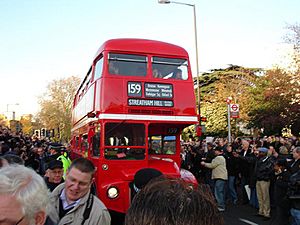
Even though Transport for London had rebuilt 50 Routemasters, the decision was made to replace them. The last Routemasters left regular service on December 9, 2005. However, two "heritage routes" (9 and 15) were introduced, using Routemasters for tourists. This was later reduced to just one route.
Here's when the Routemasters were removed from different routes:
| Route | Stopped | Operator | Replaced by |
|---|---|---|---|
| 15 | 29 August 2003 | East London | double-deckers |
| 11 | 31 October 2003 | London General | double-deckers |
| 23 | 14 November 2003 | First London | double-deckers |
| 94 | 23 January 2004 | Transdev London United | double-deckers |
| 6 | 26 March 2004 | Metroline | double-deckers |
| 98 | 26 March 2004 | Metroline | double-deckers |
| 8 | 4 June 2004 | East London | double-deckers |
| 7 | 2 July 2004 | First London | double-deckers |
| 137 | 9 July 2004 | Arriva London | double-deckers |
| 9 | 3 September 2004 | Transdev London United | double-deckers |
| 73 | 3 September 2004 | Arriva London | articulated buses |
| 390 | 3 September 2004 | Metroline | double-deckers |
| 12 | 5 November 2004 | London Central | articulated buses |
| 36 | 28 January 2005 | London Central | double-deckers |
| 19 | 1 April 2005 | Arriva London | double-deckers |
| 14 | 22 July 2005 | London General | double-deckers |
| 22 | 22 July 2005 | London General | double-deckers |
| 13 | 21 October 2005 | Transdev London Sovereign | double-deckers |
| 38 | 28 October 2005 | Arriva London | articulated buses |
| 159 | 9 December 2005 | Arriva London | double-deckers |
On December 9, 2005, the last Routemasters ran on route 159. Many people gathered to see them off. The very last Routemaster service arrived at Brixton garage at 2:06 PM, after being delayed by the crowds.
What Happened to Routemasters After 2005?
London Heritage Routes
In November 2005, special "heritage routes" (9 and 15) were started. These routes used Routemasters daily until 6:30 PM, covering short parts of regular London bus routes. Heritage Route 9 was stopped in July 2014, and Route 15 was stopped in September 2019.
The buses used on these routes were from the batch that had been rebuilt in 2001/02. Some of these heritage Routemasters were even refurbished again to look more like their original design. As of 2021, all heritage Routemaster routes have been cancelled.
Tours and Private Hires
Besides the London heritage routes, Routemasters were also used for tours in Edinburgh by Lothian Buses. These were open-top buses. The last of these were removed from service in October 2016.
Many Routemasters are still used today for private hires and special tours, like the Afternoon Tea Bus Tour in London. Some Routemasters have also been sent to other countries like Australia, Canada, China, and the United States.
50th and 60th Anniversaries
On July 25, 2004, 98 Routemasters gathered in Finsbury Park to celebrate 50 years since the first Routemaster appeared. A similar event happened in July 2014 for the 60th anniversary, with a record 136 Routemasters attending. These events were organized by the Routemaster Association.
Famous Routemasters
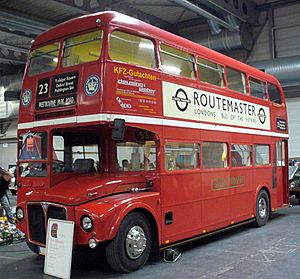
- RM1 and RM2, the first two prototypes, are kept by the London Transport Museum.
- RML3, another prototype, is preserved by the London Bus Museum.
- RMC4, a prototype coach, is also preserved.
- In 2010, some Routemasters that had been used for tours in Canada since 1965 were brought back to the UK.
- RM8, the first production Routemaster, is preserved by the RM8 Club. It was used for testing and later entered public service in 1976.
- RM1000, the 1,000th Routemaster, was given to London Transport in 1961 and is now preserved.
- FRM1, the unique rear-engined Routemaster, is preserved by the London Transport Museum.
- RM1737 is also displayed at the London Transport Museum.
- RM737 is used for private hires by The Red Bus Ltd. in Edinburgh.
- RM1403 was the first Routemaster to be converted into an open-top bus in 1984.
- RM2217 operated the very last regular Routemaster service in London in December 2005. It is now part of Arriva London's Heritage Fleet.
- RML2537 is an open-top Routemaster preserved in Long Beach, California, near the Queen Mary ship.
- RML2760, the very last Routemaster built for London, is kept by Stagecoach London.
- RCL2218, the first long coach version, is preserved at the Nottingham Transport Heritage Centre.
Images for kids
-
A Routemaster in Tampere, Finland.
-
Routemaster RM1005 in Pinner in 2012.
-
A Metroline New Routemaster on route 24 in Camden Town in 2013.
-
A Routemaster changed into a mobile "chip van" selling fish and chips.
-
A Routemaster used as a mobile radio station by Capital London, advertising Kit Kat.
See also
 In Spanish: Routemaster para niños
In Spanish: Routemaster para niños


